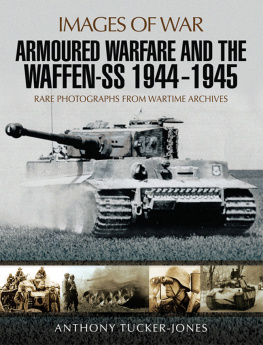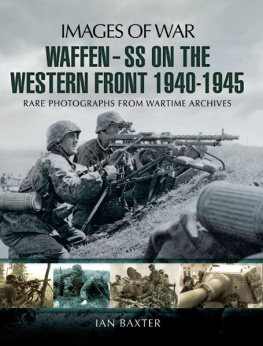
First published in Great Britain in 2009 by
PEN & SWORD MILITARY
An imprint of
Pen &Sword Books Ltd
47 Church Street
Barnsley
South Yorkshire
S70 2AS
Copyright Ian Baxter, 2009
ISBN 978 1 84415 977 2
eISBN 978 1 84468 880 7
PRC ISBN 978 1 84468 881 4
The right of Ian Baxter to be identified as Author of this work has been asserted by him in accordance with the Copyright, Designs and Patents Act 1988.
A CIP catalogue record for this book is
available from the British Library
All rights reserved. No part of this book may be reproduced or transmitted in any form or by any means, electronic or mechanical including photocopying, recording or by any information storage and retrieval system, without permission from the Publisher in writing.
Typeset by Phoenix Typesetting, Auldgirth, Dumfriesshire
Printed and bound in Great Britain by CPI UK
Pen & Sword Books Ltd incorporates the Imprints of
Pen & Sword Aviation, Pen & Sword Family History, Pen & Sword Maritime, Pen & Sword Military, Wharncliffe Local History, Pen & Sword Select, Pen & Sword Military Classics, Leo Cooper, Remember When, Seaforth Publishing and Frontline Publishing
For a complete list of Pen & Sword titles please contact
PEN & SWORD BOOKS LIMITED
47 Church Street, Barnsley, South Yorkshire, S70 2AS, England
E-mail:
Website: www.pen-and-sword.co.uk
Contents
Introduction
H itler's defeat on the Eastern Front is a unique insight into the last two years of the Wehrmacht and Waffen-SS at war. It describes how Hitler's once vaunted force played a decisive role in trying to stem the might of the Russian Army following its defeat at Kursk in the summer of 1943. Drawing on some 250 rare and previously unpublished photographs accompanied by in-depth captions and accompanying text, the book describes how the Wehrmacht and Waffen-SS franticly fought a desperate battle in the face of overwhelming enemy firepower. Despite the adverse situation in which the German Army was placed, soldiers continued to fight to the death in a bitter and frantic struggle to prevent the Red Army from reaching the frontiers of the Reich. Deluged by an armada of tanks, mass infantry assaults, and the constant hammer blows of Russian artillery the German Army along with its fanatic SS counterparts fought a series of vicious battles through the Baltic States, Byelorussia, and then built up new defences along the Vistula in Poland. But as the final months of the war were played out on the Eastern Front, the German Army, with diminishing resources, withdrew across a scarred and devastated Reich to frantically fight out the last battles around the devastated capital of Berlin.
Photographic Acknowledgements
I t is with the greatest pleasure that I use this opportunity on concluding this book to thank those who helped make this volume possible. My expression of gratitude first goes to my photographic collector Michael Cremin. He has been an unfailing source; supplying me with a number of photographs that were obtained from numerous private sources.
In Poland I am also extremely grateful to Marcin Kaludow, my Polish photographic specialist, who supplied me with a variety of photographs that he sought from private photographic collections in Poland.
Finally, I wish to display my kindness and appreciation to my American photographic collector, Richard White, who supplied me with a number of rare unpublished photographs.
The Author
I an Baxter is a military historian who specialises in German twentieth century military history. He has written more than twenty books including Wolf Hitler's Wartime Headquarters, Poland The Eighteen Day Victory March, Panzers In North Africa, The Ardennes Offensive, The Western Campaign, The 12th SS Panzer-Division Hitlerjugend, The Waffen-SS on the Western Front, The Waffen-SS on the Eastern Front, The Red Army At Stalingrad, Elite German Forces of World War II, Armoured Warfare, German Tanks of War, Blitzkrieg, Panzer-Divisions At War, Hitler's Panzers, German Armoured Vehicles of World War Two, Last Two Years of the Waffen-SS At War, German Soldier Uniforms and Insignia, German Guns of the Third Reich, Defeat to Retreat: The Last Years of the German Army At War 1943-1945, Biography of Rudolf Hoss, Operation Bagration the destruction of Army Group Centre, and most recently The Afrika-Korps. He has written over one hundred journals including Last days of Hitler, Wolf's Lair, Story of the VI and V2 Rocket Programme, Secret Aircraft of World War Two, Rommel At Tobruk, Hitler's War With His Generals, Secret British Plans To Assassinate Hitler, SS At Arnhem, Hitlerjugend, Battle Of Caen I944, Gebirgsjger At War, Panzer Crews, Hitlerjugend Guerrillas, Last Battles in the East, Battle of Berlin, and many more. He has also reviewed numerous military studies for publication and supplied thousands of photographs and important documents to various publishers and film Production Companyies worldwide.
Chapter One
Kursk
O n 5 July 1943, both the Wehrmacht and their Waffen-SS counterparts stood poised ready to go into action, the pre-dawn light was shattered by a massive German bombardment. The artillery barrage was so intense that in no less than one hour German gunners had hurled more shells than they had used in both Poland and the Western campaigns put together. Despite this violent bombardment, Soviet artillery responded with equal ferocity that soon confirmed what all Germans feared: the attack was not a surprise. All over the front, Soviet artillery crews fired at known German artillery positions that caught the German gunners in the open.
Within hours of the artillery bombardment, three Waffen-SS divisions were engaged in the opening stages of the greatest armoured clash in history. The task of the SS.Panzer-Korps was to advance via Beresov and Sadeynoye, and breaking through the first defensive belt. Between Lutchki and Jakovlevo was the second line of Russian defensive positions, and when these were destroyed the advance would follow in a general northeastern direction. For this operation the l67. Infanterie-Division would form part of the SS Korps and would guard the left flank.
The Leibstandarte's first attack went well, and their armour soon encircled enemy units that were destroyed with supporting grenadiers. The 9.Kompanie of the Leibstandarte's 2.SS.Panzergrenadier-Regiment captured two hills west of Byelgorod and took five fortified positions with explosive charges. The soldiers of the Totenkopf division too wasted no time and smashed onto a series of strong Soviet defence lines. At the same time the Das Reich division made considerable progress, and infiltrated enemy lines in front of them.
By evening of the first day of the attack Totenkopf, with its new Tiger tanks leading the advance had reached the second Russian defensive belt and managed to capture the village of Yakhontovo and taken an important command post of the Soviet 69th Army. Both the Leibstandarte and Das Reich had done equally as well. With their Tigers and Panzer.IV's they had penetrated some 13 miles into the Russian defences.
By 7 July, the advance of the Wehrmacht and Waffen-SS seemed more promising than ever. German forces had managed to smash its way through more than 30 miles of Russian line, whilst in some areas they were equally successful despite enduring bitter fighting. German battle reports confirmed that given the amount of Soviet prisoners taken and the damage inflicted on their lines, it appeared that the Germans were poised on the edge of victory. However, they had not even yet encountered the main enemy positions. The fact that they had advanced at such speed had enabled the Russians to take full advantage of attacking the German flanks.
Next page


















